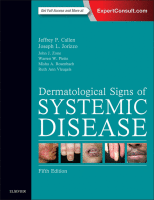Physical Address
304 North Cardinal St.
Dorchester Center, MA 02124

Key Points Skin manifestations of chronic kidney disease (CKD) are commonly encountered and can be due to (1) the cause of the underlying renal disease, either acquired or heritable; (2) conditions unique to uremia; or (3) immunosuppressive therapies and/or immunosuppression…

Key Points Several systemic disorders can affect both the heart and the skin. Cutaneous findings may serve as a diagnostic clue for many of these conditions. Dermatologists and cardiologists must be aware of the multisystem aspects of such disorders in…

Key Points Sarcoidosis is a multisystem granulomatous disease of unknown etiology that affects patients of all ages and ethnic groups. Thorough multisystem evaluation of all patients is essential, as sarcoidal inflammation may be clinically quiescent while causing significant damage. Cutaneous…

Key Points Patients with HIV/AIDS may develop cutaneous manifestations that reflect their immune-compromised state and can be grouped into infections (viral, bacterial, fungal, and parasitic/ectoparasitic), inflammatory, neoplastic, or other conditions. Syphilis, caused by Treponema pallidum , is a sexually transmitted…

Key Points Trichomoniasis typically presents with vaginal pruritus and a frothy discharge, and responds well to treatment with metronidazole. Systemic therapy for leishmaniasis is recommended for patients who are immunosuppressed or who acquire infection in areas where mucocutaneous disease has…

Key Points Fungal pathogens affect the skin in many ways: superficial fungi, such as the dermatophytes, rarely cause systemic disease. Subcutaneous mycoses, such as sporotrichosis, mycetoma, and chromoblastomycosis, are typically caused by minor, inadvertent trauma that introduces environmental fungi into…

Key Points Most Gram-positive skin infections can be treated with a semisynthetic penicillin or a cephalosporin. Meticillin-resistant staphylococcal infections typically present as abscess or folliculitis. The primary intervention is drainage. Lyme disease typically presents with erythema migrans and responds to…

Key Points Measles is generally a benign, self-limited illness that presents with erythematous, confluent macules and papules that spread cephalocaudally and Koplik spots. Hand, foot, and mouth syndrome, caused by various Coxsackie viruses, is a self-limited illness that presents with…

Key Points The cutaneous changes of hepatic disease may be related to primary diseases of the liver, cutaneous diseases with associated hepatic abnormalities, disorders with changes in many organs, including the liver and skin, and medications with direct effects on…

Key Points Gastrointestinal hemorrhage may be associated with pseudoxanthoma elasticum or hereditary hemorrhagic telangiectasia. Adenomatous polyposis may be associated with epidermoid tumors, fibromas, and dermoid tumors. Peutz–Jeghers syndrome and Cowden’s syndrome are associated with hamartomatous polyps. Malabsorption may be associated…